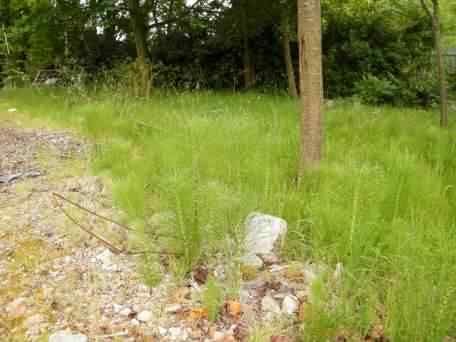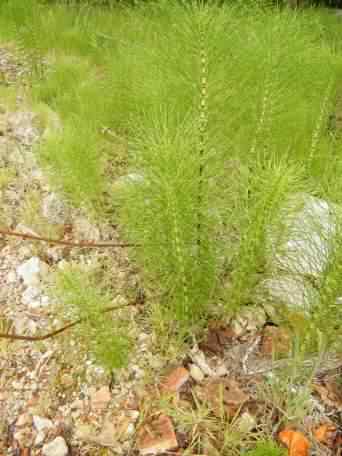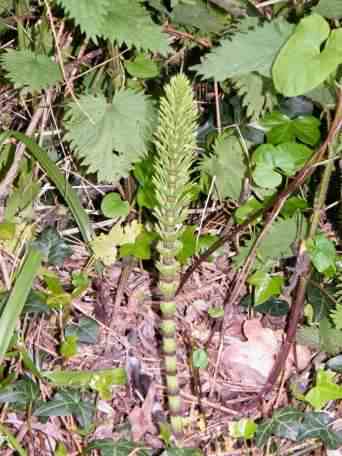


Photos ©2012–
Click any photo for a larger image
Field Horsetail - Equisetum arvense
Family - Equisetaceae
Also known as - Snake Grass, Scour Rush
Field horsetail is a perennial plant growing to 75cm (30in) forming patches of dense growth in grassy areas and waste ground. It will be found over many parts of the world although they are not native to Australia and New Zealand, growing in sandy soils, wet clay soils, indeed some species of Horsetail are aquatic. Generally they can be a herbaceous plant in temperate areas or an evergreen in tropical climes. The stems are coated with abrasive silicates, a fact that has made them useful in the past for cleaning kitchen utensils, particularly those made of tin. Often referred to as a "living fossil". The German name "Zinnkraut" literally means "tin–herb". In Japan E. hyemale is boiled and dried to a powder and used for polishing woodcraft to produce a smoother finish than any sandpaper.
Equisetaceae a family of vascular plants that reproduce by spores as do ferns, rather than by setting seed. Two stem types produced, fertile at 10–20cm (4–8in) high produced before the unfertile which are usually about 50cm (20in) high, with dark green ridged stems and disks of small branches. Fertile stems appear in the spring with a brown cone spike ripening and releasing the spores during March to April. It has a long rhizome root system always growing in wet areas, ponds, marshes, ditches and flood meadows producing stems at close intervals, with the number of leaves matching the number of stem ridges. A pervasive growth usually regarded as a weed that is hard to eradicate, with regular mowing seeming to work the best. The common name "horsetail" reputedly arose because the species branched growth form somewhat resemble a horse's tail. The scientific name Equisetum derives from the Latin "equus" (horse) and "seta" (bristle). Botanical description for Arvense meaning of cultivated fields.
The stalks grow from rhizomes that are deep underground and almost impossible to dig out to the extent that Horsetails can be a nuisance weed, readily regrowing from the rhizome, it is also unaffected by many herbicides. Several plants in the genus are classified as noxious weeds in Australia and the US. In New Zealand all Equisetum are classed as unwanted organisms and are listed on the National Pest Plant Accord. Horsetail leaves are arranged in whorls fused into nodal sheaths, the stems are green, photosynthetic, and are distinctive in being hollow, jointed and ridged (with 6–40 ridges). There may or may not be whorls of branches at the nodes. It has a long history of medicinal uses, although modern sources include cautions with regard to its use. In 2009 the European Food Safety Authority issued a report assessing health claims (invigoration, weight control, skin, hair, and bone health) for Equisetum arvense L., concluding that none could be substantiated.
BCP do not advise or recommend that Field Horsetail – Equisetum arvense is eaten or used as an herbal remedy. The young plants are eaten cooked or raw, but considerable care must be taken. In Japan when cooked and eaten like Asparagus it is a dish called "tsukushi". Toxicity appears to be due to thiaminase enzymes, which can cause thiamine deficiency. The plants are used as a dye giving a soft green colour. An extract is often used to provide silica.
 |
 |
 |
Photos ©2012– Click any photo for a larger image |
Site design ©1999– Brickfields Country Park - Privacy -